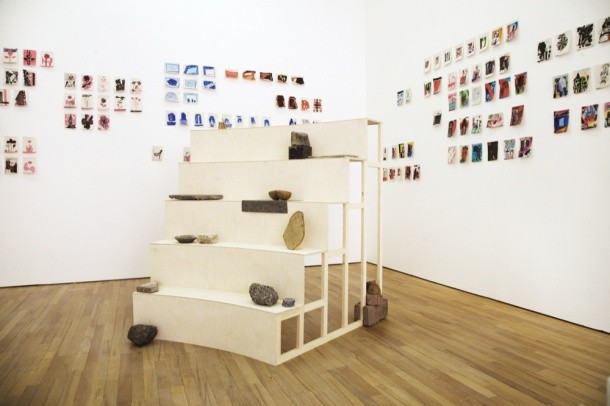Andreas Mangione
21 Feb - 18 May 2014
ANDREAS MANGIONE
the sound is gone but not forgotten
21 February – 18 May 2014
In some parts of Japan there is a tale about the Yamabiko (Echo), a spirit creature that dwells in the mountains. Very seldom seen but more often heard, it is the Yamabiko that replies back to you when you shout out. It is the embodiment of echo. Nowadays, however, some say that the Yamabiko is on the brink of extinction. They say it is because nature is getting more and more silent. The question is if they mean the kind of silence that appears when there is no one listening. Listening is not a very favoured skill in our society. What counts is speech and rhetorics.
Now, try and imagine a different form of listening, a listening that zooms in on everything from the weakest of sounds to the loudest of noise. A kind of listening that opens up a new universe both within the sounding and the silence of objects. A listening that can be applied on all things, like a new way of seeing.
To approach such a listening, one could for instance begin with the following kōan:
What is the sound of one hand clapping?
A kōan is a kind of philosophical trigger to provoke the “great doubt” in order to test one’s progress in Zen-practice. To dwell on details through the act of listening, observing and a close examination of all things around you is where Andreas Mangione’s artistic practice unfolds. A practice where found things trigger the imagination, the day dream and the creative process. Like a drift. He collects things, the remains of actions, events and broken promises left behind in between the buildings in his immediate surroundings, the suburbs of the city. Leftovers he manages to carry with him home. The insignificant parts of society. Burned pieces of wood, stones, fragments of concrete, pieces of metal and plastic, and so on. Found shapes and objects which then reappear in his works. Coincidence and a feeling of wonder when a thing happens to resemble another thing are focal points in his quest to open up different layers of meaning within the objects and shapes he finds.
Like a sonar Andreas Mangione scans the terrain he is passing through on his everyday walks, on the same paths through his neighbourhood. The remains, the small insignificant parts, catch his eyes and ears. The details of everyday life. Fragments, but also vessels for inherent stories. These stories are then assembled, rearticulated and told through sculpture and drawing. A continuous transformation, silent but with the act of listening very present.
the sound is gone but not forgotten
21 February – 18 May 2014
In some parts of Japan there is a tale about the Yamabiko (Echo), a spirit creature that dwells in the mountains. Very seldom seen but more often heard, it is the Yamabiko that replies back to you when you shout out. It is the embodiment of echo. Nowadays, however, some say that the Yamabiko is on the brink of extinction. They say it is because nature is getting more and more silent. The question is if they mean the kind of silence that appears when there is no one listening. Listening is not a very favoured skill in our society. What counts is speech and rhetorics.
Now, try and imagine a different form of listening, a listening that zooms in on everything from the weakest of sounds to the loudest of noise. A kind of listening that opens up a new universe both within the sounding and the silence of objects. A listening that can be applied on all things, like a new way of seeing.
To approach such a listening, one could for instance begin with the following kōan:
What is the sound of one hand clapping?
A kōan is a kind of philosophical trigger to provoke the “great doubt” in order to test one’s progress in Zen-practice. To dwell on details through the act of listening, observing and a close examination of all things around you is where Andreas Mangione’s artistic practice unfolds. A practice where found things trigger the imagination, the day dream and the creative process. Like a drift. He collects things, the remains of actions, events and broken promises left behind in between the buildings in his immediate surroundings, the suburbs of the city. Leftovers he manages to carry with him home. The insignificant parts of society. Burned pieces of wood, stones, fragments of concrete, pieces of metal and plastic, and so on. Found shapes and objects which then reappear in his works. Coincidence and a feeling of wonder when a thing happens to resemble another thing are focal points in his quest to open up different layers of meaning within the objects and shapes he finds.
Like a sonar Andreas Mangione scans the terrain he is passing through on his everyday walks, on the same paths through his neighbourhood. The remains, the small insignificant parts, catch his eyes and ears. The details of everyday life. Fragments, but also vessels for inherent stories. These stories are then assembled, rearticulated and told through sculpture and drawing. A continuous transformation, silent but with the act of listening very present.

